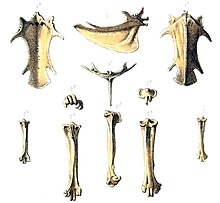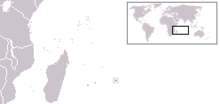Rodrigues pigeon
| Rodrigues pigeon | |
|---|---|

| |
Subfossil bones, 1873. The bones below (2) where originally assigned to the Malagasy turtle dove
| |
| Scientific classification | |
| Domain: | Eukaryota |
| Kingdom: | Animalia |
| Phylum: | Chordata |
| Class: | Aves |
| Order: | Columbiformes |
| Family: | Columbidae |
| Genus: | Nesoenas |
| Species: | †N. rodericanus
|
| Binomial name | |
| †Nesoenas rodericanus (Milne-Edwards, 1873)
| |

| |
| Location of Rodrigues | |
| Synonyms | |
|
Columba rodericana Milne-Edwards, 1873 | |
The Rodrigues pigeon or Rodrigues dove (Nesoenas rodericanus) is an
(1726).Taxonomy

This bird was assigned to the genus
Two tarsometatarsi were attributed to this species. Today, they are believed to represent another taxon, closer to the Malagasy turtle dove (Nesoenas picturata), and thus the name Rodrigues turtle dove also refers to the present species.
Description
It was a bird the size of a tambourine dove and colored slate grey. Leguat and his companions took a fancy to these tame and confiding birds and had several dozen birds attending their outdoor table at mealtime to wait for scraps; they were especially fond of melon seeds. In 1693, the bird was found foraging on the island, but nested only on offshore islets which the rats that had been introduced at some time in the 17th century had not yet reached.[2]
Behaviour
Leguat described its behaviour as follows:
The pigeons here are somewhat less than ours and all of a slate colour, fat and good. They perch and build their nests upon trees; they are easily taken, being so tame, that we have had fifty about our table to pick up the melon seeds which we threw them, and they lik’d mightily. We took them when we pleas’d, and ty’d little rags to their thighs of several colours, that we might know them again if we let them loose. They never miss’d attending us at our meals, and we call’d them our chickens. They never built their nests in the Isle, but in the little islets that are near it. We suppos’d ‘twas to avoid the persecution of rats, of which there are vast numbers in this Island...[2]
Tafforet described its behaviopur as follows:
The turtle doves there [Rodrigues] are in great numbers, but on the mainland one sees very few, because they go to feed on the islets to the south, as do the parrots, and come to drink likewise on the mainland [Hume's translation].[2]
Extinction
Tafforet's report is the last record of this species. It can be assumed to have gone extinct in the mid-18th century, when rats finally overran its nesting sites.
References
- . Retrieved 12 November 2021.
- ^ ISBN 978-1-86977-826-2(online edition)
- Milne-Edwards, Alphonse (1873): Recherches sur la faune ancienne des Îles Mascareignes. Ann. Sci. Nat. Zool. (Paris) 5(19), Article 3, plate 12: figures 1, 1a, 1b, 1c. [Article in French] Note: Usually, the year of publication is given as 1874. However, although the volume was nominally of that year, it was already released in 1873.

